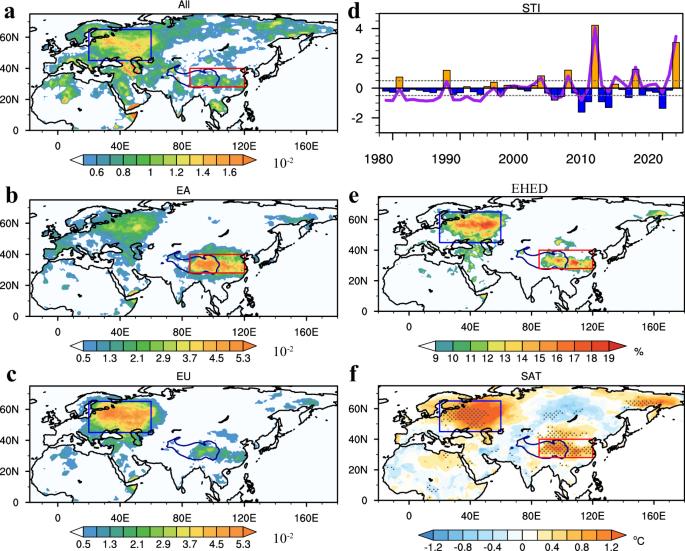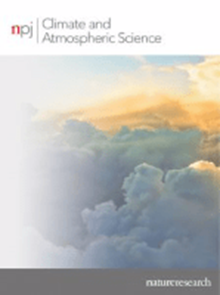青藏高原干燥的土壤水分导致欧洲和东亚出现同步极端热浪
IF 8.5
1区 地球科学
Q1 METEOROLOGY & ATMOSPHERIC SCIENCES
引用次数: 0
摘要
最近,极端热浪频频同时席卷欧洲和东亚,造成了严重的连锁社会经济后果。然而,人们对这些热浪之间的非线性同步关系及其背后的物理机制仍然知之甚少。利用事件同步气候网络方法、大气动态诊断和数值实验,我们揭示了欧洲和东亚热浪之间的强同步性,这与青藏高原从冬季到夏季的干燥土壤水分条件密切相关。干燥的土壤水分触发了青藏高原以北的等效气压反气旋,与副热带西风喷流波导相吻合,并引发了向西和向东传播的环全球大气罗斯比波。因此,欧洲上空出现了等效的气压反气旋。这些反气旋通过增加向下的太阳辐射和绝热下沉,在陆地-大气正反馈的作用下,在欧洲和东亚同时引发热浪。我们的发现极大地增强了对欧亚大陆同步热浪的理解和预测能力。本文章由计算机程序翻译,如有差异,请以英文原文为准。


Dry soil moisture on the Tibetan plateau drives synchronous extreme heatwaves in Europe and East Asia
Recently, extreme heatwaves have frequently concurrently swept across Europe and East Asia, causing severe cascading socioeconomic consequences. However, the nonlinear synchronization relationship between these heatwaves and their underlying physical mechanisms remains poorly understood. Utilizing the event synchronization climate network method, atmospheric dynamic diagnostics, and numerical experiments, we revealed robust synchronization between heatwaves over Europe and East Asia, strongly associated with dry soil moisture conditions over the Tibetan Plateau from the preceding winter to summer. Dry soil moisture triggers an equivalent barotropic anticyclone north of the Tibetan Plateau, coinciding with the subtropical westerly jet waveguide and initiating circumglobal atmospheric Rossby waves propagating westward and eastward. Consequently, an equivalent barotropic anticyclone develops over Europe. These anticyclones induce simultaneous heatwaves across Europe and East Asia by increasing downward solar radiation and adiabatic sinking, amplified by positive land-atmosphere feedback. Our findings significantly enhance the understanding and predictive capabilities of these synchronous heatwaves across Eurasia.
求助全文
通过发布文献求助,成功后即可免费获取论文全文。
去求助
来源期刊

npj Climate and Atmospheric Science
Earth and Planetary Sciences-Atmospheric Science
CiteScore
8.80
自引率
3.30%
发文量
87
审稿时长
21 weeks
期刊介绍:
npj Climate and Atmospheric Science is an open-access journal encompassing the relevant physical, chemical, and biological aspects of atmospheric and climate science. The journal places particular emphasis on regional studies that unveil new insights into specific localities, including examinations of local atmospheric composition, such as aerosols.
The range of topics covered by the journal includes climate dynamics, climate variability, weather and climate prediction, climate change, ocean dynamics, weather extremes, air pollution, atmospheric chemistry (including aerosols), the hydrological cycle, and atmosphere–ocean and atmosphere–land interactions. The journal welcomes studies employing a diverse array of methods, including numerical and statistical modeling, the development and application of in situ observational techniques, remote sensing, and the development or evaluation of new reanalyses.
 求助内容:
求助内容: 应助结果提醒方式:
应助结果提醒方式:


